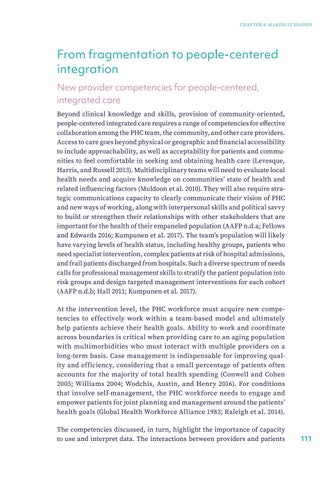CHAPTER 4: MAKING IT HAPPEN
From fragmentation to people-centered integration New provider competencies for people-centered, integrated care Beyond clinical knowledge and skills, provision of community-oriented, people-centered integrated care requires a range of competencies for effective collaboration among the PHC team, the community, and other care providers. Access to care goes beyond physical or geographic and financial accessibility to include approachability, as well as acceptability for patients and communities to feel comfortable in seeking and obtaining health care (Levesque, Harris, and Russell 2013). Multidisciplinary teams will need to evaluate local health needs and acquire knowledge on communities’ state of health and related influencing factors (Muldoon et al. 2010). They will also require strategic communications capacity to clearly communicate their vision of PHC and new ways of working, along with interpersonal skills and political savvy to build or strengthen their relationships with other stakeholders that are important for the health of their empaneled population (AAFP n.d.a; Fellows and Edwards 2016; Kumpunen et al. 2017). The team’s population will likely have varying levels of health status, including healthy groups, patients who need specialist intervention, complex patients at risk of hospital admissions, and frail patients discharged from hospitals. Such a diverse spectrum of needs calls for professional management skills to stratify the patient population into risk groups and design targeted management interventions for each cohort (AAFP n.d.b; Hall 2011; Kumpunen et al. 2017). At the intervention level, the PHC workforce must acquire new competencies to effectively work within a team-based model and ultimately help patients achieve their health goals. Ability to work and coordinate across boundaries is critical when providing care to an aging population with multimorbidities who must interact with multiple providers on a long-term basis. Case management is indispensable for improving quality and efficiency, considering that a small percentage of patients often accounts for the majority of total health spending (Conwell and Cohen 2005; Williams 2004; Wodchis, Austin, and Henry 2016). For conditions that involve self-management, the PHC workforce needs to engage and empower patients for joint planning and management around the patients’ health goals (Global Health Workforce Alliance 1983; Raleigh et al. 2014). The competencies discussed, in turn, highlight the importance of capacity to use and interpret data. The interactions between providers and patients
111


